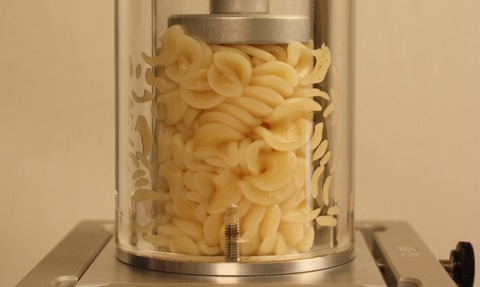
Texture Technologies has developed a new method to test pasta firmness by cook time and across brands.
Many consumers demand a pasta that easily cooks “al dente”. To meet consumer demands, pasta manufacturers have developed successful methods for testing the firmness of cooked spaghetti and Asian noodles.
However, they have struggled to find a common method for testing irregularly shaped pastas such as farfalle, rotini, and penne.
Without a common testing method, manufacturers found it difficult to compare pasta firmness across different pasta formulations, shapes, and sizes as well as vendors.
Previous testing methods for firmness were too dependent on pasta shape and could not produce useful data that incorporates all the variables that the pasta industry faced. A new testing method was clearly needed.
Working with the pasta industry to address this challenge, Texture Technologies has developed a new method to test pasta firmness by cook time within and across brands and pasta shape.
Using the TA.XTPlus TextureAnalyzer with the new TA-93WST Wire Mesh Extrusion Fixture, manufacturers are now able to qualify the firmness of irregular shaped pasta with this differentiating testing method.
The method involves extruding a 120-gram sample of cooked, drained pasta across the TA-93WST’s wire mesh screen. The wire mesh shears the pasta much more thoroughly than older methods that cut individual pieces of pasta.
The 120g sample is so thoroughly sheared that the measured firmness strongly represents the entire batch. Manufacturers can then use the resulting data to determine firmness by comparing the average force needed to shear the pasta with cook time.
According to the company, the method is extremely repeatable and can be easily used as part of a quality control methodology and for product improvements.
Food manufacturers that use multiple suppliers for their pasta products can utilise the testing method to isolate product performance by supplier.
For pasta manufacturers, the testing method can provide valuable data for reformulating products for shorter cooking time and a longer window before overcooking, improving their products’ “al dente” texture that consumers prefer.

